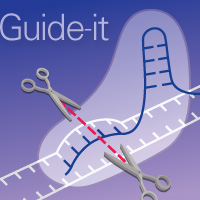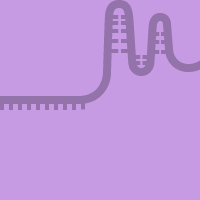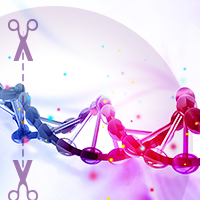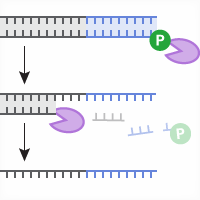The use of CRISPR/Cas9 technology can be limited by delivery options for Cas9 and the single guide RNA (sgRNA). Transfection of cells with plasmids encoding Cas9 and sgRNA is the most commonly used method. However, many human cell types are considered hard-to-transfect, making plasmid-based delivery difficult. One alternate strategy for delivering CRISPR/Cas9 components to these cell types is viral transduction.
Tech Note
Improved CRISPR/Cas9 genome editing in hard-to-transfect mammalian cells using AAV
- Viruses encoding truncated portions of Cas9 with a 1.6-kb region of homology are prepared in HEK 293T packaging cells:
Recombination in target cells results in a full-length Cas9 gene expression cassette - An innovative method to deliver the large Cas9 gene with a small virus:
To overcome the size limitation of AAV, the Cas9 gene is divided between two vectors - AAV-mediated delivery of Cas9 and sgRNA expression cassettes results in more indels, especially in hard-to-transfect cell lines:
A higher rate of mutation is obtained with AAV-mediated delivery of Cas9 and sgRNA compared to transfection-based delivery
Introduction
Results
Advantages of AAV for CRISPR/Cas9 delivery
Recombinant adeno-associated virus (AAV) has several advantages over other types of viruses for gene delivery. Importantly, AAV does not integrate into the host genome, precluding genomic integration and sustained expression of Cas9, thereby reducing the likelihood of Cas9 off-target effects. AAV also exhibits lower immunogenicity and has a small genome relative to other non-integrating viruses (e.g., adenovirus), making it easier to manipulate.
An AAV-based system for Cas9 and sgRNA delivery
The small size of the AAV genome can be a limitation when packaging a large gene such as the S. pyogenes Cas9 (SpCas9). The 4.1-kb SpCas9 gene together with its optimal promoter and polyadenylation signal exceeds the capacity that can be efficiently packaged into AAV viral particles (Byrne, Mali, and Church 2014). To overcome this limitation, we developed a system that takes advantage of DNA recombination that is inherent to AAV genome processing (Hirsch, Agbandje-McKenna, and Samulski 2010). The vectors included with the AAVpro CRISPR/Cas9 Helper Free System (AAV2) split the Cas9 gene into two portions (Cas9-Up and Cas9-Down) that have a 1.6-kb shared region of homology (Figure 1). This homologous region mediates recombination with high efficiency inside the target cell, thereby producing a full-length Cas9 expression cassette.

Figure 1. AAV vector recombination to produce full-length Cas9. The large size of the Cas9 gene (4.1 kb) precludes its packaging into a single AAV particle. The pAAV-Guide-it-Up and pAAV-Guide-it-Down plasmids contain truncated upstream and downstream portions of Cas9 respectively, with a shared 1.6-kb region of homology. Separate viruses are generated with each plasmid. Transduction of target cells with both viruses results in recombination to generate a full-length Cas9 expression cassette. Upstream and downstream portions of Cas9, with a shared 1.6-kb region of homology are split between two separate plasmids, pAAV-Guide-it-Up and pAAV-Guide-it-Down, respectively (Figure 2). A user-defined guide sequence is cloned into the pAAV-Guide-it-Down plasmid, which is provided prelinearized to allow for seamless, single-step cloning (Figure 2B).

Figure 2. Vector maps of pAAV-Guide-it-Up and pAAV-Guide-it-Down. Panel A. The pAAV-Guide-it-Up plasmid contains a truncated upstream portion of Cas9 (3,106 bp) that encodes the N-terminal 1,035 amino acids of Cas9 under the control of the CMV promoter. Panel B. The pAAV-Guide-it-Down plasmid contains the downstream portion of Cas9 (2,616 bp) that encodes the C-terminal 872 amino acids, and is provided pre-linearized. A gene-specific guide sequence can be cloned into the pAAV-Guide-it-Down plasmid downstream of the human U6 promoter. Oligos encoding the sgRNA are annealed to form a duplex. The duplexed DNA is then cloned into the pre-linearized pAAV-Guide-it-Down plasmid.
The AAVpro CRISPR/Cas9 Helper Free System workflow
The AAVpro CRISPR/Cas9 Helper Free System (AAV2) is a complete system for the delivery of Cas9 and a gene-specific sgRNA to mammalian cells using AAV2 (AAV serotype 2). First, oligos encoding a gene-specific guide sequence are annealed to form duplexes. The duplexed DNA is ligated to the pre-linearized pAAV-Guide-it-Down plasmid (Figure 2B). All the components needed for the annealing and ligation of the oligos are provided. AAV2-Up and AAV2-Down viruses are packaged independently in a HEK 293T packaging cell line. Packaging cells are transfected with the respective pAAV-Guide-it-Up and pAAV-Guide-it-Down plasmids, and the pHelper and pRC2-mi342 plasmids that encode viral packaging components and miRNA-342, a human microRNA that increases AAV2 titer. AAV2 viral particles are then extracted using the included AAVpro Extraction Solution. Target cells are then transduced with equal number of AAV2-Up and AAV2-Down viruses to ensure efficient recombination. Recombination between Cas9-Up and Cas9-Down within target cells results in a full-length Cas9 gene expression cassette. Following transcription and translation, Cas9 is guided to the target genomic locus by the sgRNA, where it creates a double-stranded break.

Figure 3. Workflow of the AAVpro CRISPR/Cas9 Helper Free System (AAV2). The pAAV-Guide-it-Up and pAAV-Guide-it-Down vectors encode truncated upstream and downstream portions of the Cas9 gene, respectively, with a 1.6-kb overlapping region of homology. Duplexed guide-sequence oligos targeting a specific gene are ligated to the pre-linearized pAAV-Guide-it-Down plasmid. Separate AAV2-Up and AAV2-Down viruses are generated by transfecting HEK 293T cells with either pAAV-Guide-it-Up or pAAV-Guide-it-Down along with pRC2-mi342 and pHelper plasmids. The resulting viral particles are isolated using AAV Extraction Solution. Target cells are co-transduced with equal numbers of both AAV2-Up and AAV2-Down viruses. The 1.6-kb homologous region results in recombination during AAV genome processing giving rise to full-length Cas9 that is transcribed and translated. The Cas9-sgRNA complex then mediates cleavage of the target gene.
Produce consistent and equivalent high-titer AAV2-Up and AAV2-Down virus
To ensure efficient genome editing, obtaining high and equivalent titers of both AAV2-Up and AAV2-Down virus is critical. AAV2-Up and AAV2-Down viral particles encoding truncated portions of Cas9 and a sgRNA targeting CCR5 were generated in three independent experiments using the AAVpro CRISPR/Cas9 Helper Free System (AAV2) (Figure 4). Identically high titers were obtained for both viruses. The AAVpro Extraction Solution, which is provided with the kit, results in viral yields that are 3 times higher than those obtained with traditional freeze-thaw methods.

Figure 4. Consistent recovery of equally high genomic titers of AAV2-Up and AAV2-Down viral particles. AAV2-Up and AAV2-Down viral particles encoding a sgRNA targeting CCR5 and truncated portions of Cas9 were extracted from HEK 293T cells using the AAVpro Extraction Solution. Genomic titer was measured using the AAVpro Titration Kit (for Real Time PCR). Equivalent and high genomic titers were obtained for AAV2-Up and AAV2-Down viral particles in three independent experiments.
AAV2 delivery of Cas9 and sgRNA results in more indels compared to plasmid transfection
The CCR5 gene, which encodes a cell surface chemokine receptor, was targeted for CRISPR/Cas9 editing. Oligos containing a guide sequence targeting the CCR5 gene were designed, annealed, and ligated to the pAAV-Guide-it-Down plasmid. AAV2-Up and AAV2-Down viruses were packaged following the recommended protocol. HEK 293, HepG2, and MCF7 cells were then co-transduced with equal numbers of AAV2-Up and AAV2-Down viruses. In this experiment, HEK 293 is considered an easy-to-transfect cell line and HepG2 and MCF7 are considered hard-to-transfect cell lines. As a control, cells were transfected with a plasmid encoding Cas9 and a sgRNA targeting CCR5 by transfection. Seventy-two hours after either transfection or transduction, cells were harvested and analyzed using the Guide-it Mutation Detection Kit, a method that employs a mismatch specific endonuclease to identify insertions or deletions (indels). The resulting cleavage reaction was analyzed by agarose gel electrophoresis (Figure 5). The percentage of indels was quantified using densitometry (Cong et al. 2013). As anticipated, plasmid transfection of Cas9-sgRNA yielded significant indel formation only in HEK 293 cells. For the hard-to-transfect cells, HepG2 and MCF7 cells, there was almost no detectable indel formation (Figure 5). Conversely, AAV2-mediated delivery of Cas9-sgRNA complexes yielded significant indel formation in both HEK 293 and the hard-to-transfect cells (Figure 5). Interestingly, the fold difference in indel formation between transfection and transduction was far more pronounced in HepG2 and MCF7 cells than HEK 293 cells (5.6- and 6.3-fold versus 2.0-fold). These data underscore the efficacy of the AAVpro CRISPR/Cas9 Helper Free System (AAV2) at inducing site-specific genomic modifications in hard-to-transfect cells.

Figure 5. The AAVpro CRISPR/Cas9 system results in more indel formation than plasmid transfection, especially in hard-to-transfect cell lines. The indicated cell types (1.0 x 105 cells) were seeded in 12-well plates one day before either transfection or transduction. Cells were transduced with 1.0 x 105 MOI (genomic titer) each of AAV2-Up and AAV2-Down viral particles targeting the CCR5 gene. Genomic titers were calculated using the AAVpro Titration Kit (for Real Time PCR). After 72 hours, cells were harvested and analyzed using the Guide-it Mutation Detection Kit. As a control, Guide-it-ZsGreen1 plasmid (P: 2.5 µg) targeting the CCR5 gene was introduced by transfection. As a negative control ("-"), cells without either transfection or transduction were included in the analysis. Indel formation (%) was assessed by agarose gel electrophoresis and measured using densitometry.
Conclusions
The AAVpro CRISPR/Cas9 Helper Free System (AAV2) is a complete system for the delivery of Cas9 and sgRNA to mammalian cells using AAV2. The kit contains all of the necessary reagents to prepare infection-ready, high-titer AAV particles to deliver Cas9 and a user-defined, gene-specific sgRNA. AAV-mediated delivery of Cas9 and sgRNA using this system, results in greater genome editing compared to plasmid transfection delivery, especially in hard-to-transfect cells.
References
Byrne, S. M., Mali, P. & Church, G. M. Genome editing in human stem cells. Methods Enzymol. 546, 119–38 (2014).
Cong, L. et al. Multiplex Genome Engineering Using CRISPR/Cas Systems. Science (80). 339, 819–823 (2013).
Hirsch, M. L., Agbandje-McKenna, M. & Samulski, R. J. Little vector, big gene transduction: fragmented genome reassembly of adeno-associated virus. Mol. Ther. 18, 6–8 (2010).
Related products
Gene editing resources
Product finder
Use this gene editing product finder to quickly locate kits for screening, delivery, and downstream assays.
CRISPR tools and information
What is CRISPR/Cas9? Need help designing the best guide RNAs? Learn all this and more.
Genome-wide library screening
Learn how to conduct a CRISPR/Cas9 guide RNA library phenotypic screen and view data demonstrating the use of our library.
CRISPR/Cas9 knockouts
Technotes and tools used to create or study CRISPR-Cas9-mediated gene knockouts (indels).
CRISPR/Cas9 knockins
Information, technotes and tools used to create or study gene knockouts by CRISPR/Cas9 and HDR.
Takara Bio USA, Inc.
United States/Canada: +1.800.662.2566 • Asia Pacific: +1.650.919.7300 • Europe: +33.(0)1.3904.6880 • Japan: +81.(0)77.565.6999
FOR RESEARCH USE ONLY. NOT FOR USE IN DIAGNOSTIC PROCEDURES. © 2025 Takara Bio Inc. All Rights Reserved. All trademarks are the property of Takara Bio Inc. or its affiliate(s) in the U.S. and/or other countries or their respective owners. Certain trademarks may not be registered in all jurisdictions. Additional product, intellectual property, and restricted use information is available at takarabio.com.









